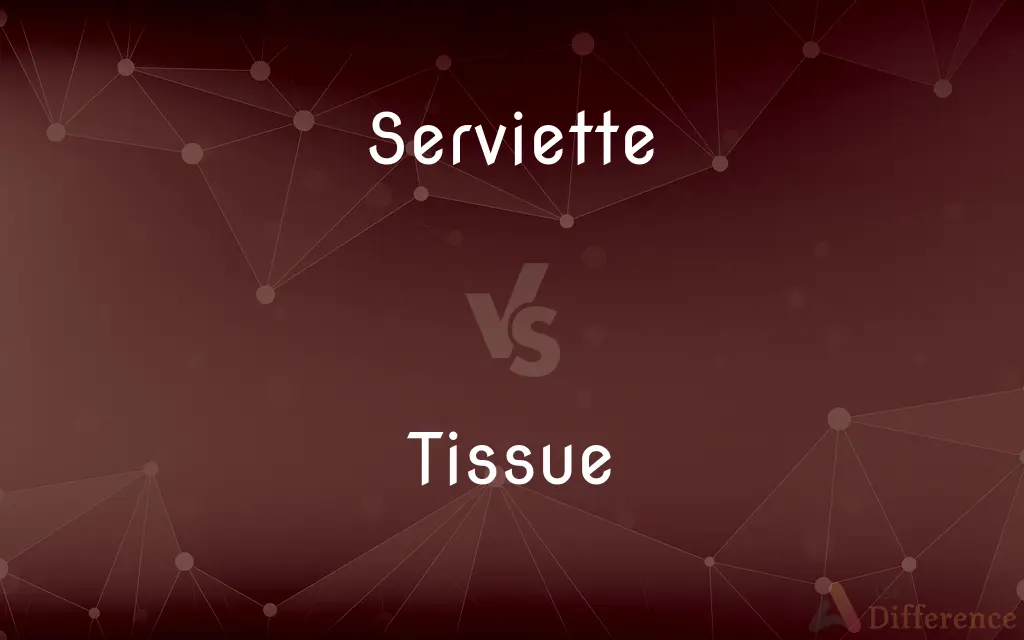Serviette vs. Tissue — What's the Difference?
Edited by Tayyaba Rehman — By Urooj Arif — Updated on April 5, 2024
A serviette is a piece of fabric or paper used at the dining table to wipe the mouth and hands during meals, while a tissue is a thin, soft paper used for various personal hygiene purposes, including blowing the nose.

Difference Between Serviette and Tissue
Table of Contents
ADVERTISEMENT
Key Differences
Serviettes, often made from fabric in more formal settings, are specifically designed for use during meals. They are usually larger and sometimes more decorative, intended to be placed on the lap or near the plate to be used throughout a dining experience for cleanliness and etiquette. Tissues, on the other hand, are versatile, thin sheets of soft paper, designed primarily for personal hygiene. They are commonly used to blow or clean the nose, but their usage extends to wiping tears, cleaning small spills, or as a makeshift covering for sneezes and coughs.
Paper serviettes, commonly used in less formal settings or eateries, serve the same purpose but are disposable. The term "serviette" can be more commonly used in certain regions, such as the UK and Commonwealth countries, reflecting a cultural preference in terminology. Tissues are typically packaged in boxes or soft packs for easy carrying and are designed to be disposable, emphasizing hygiene and convenience. The softness and absorbency of tissues make them suitable for delicate skin, which is why they are preferred for facial use.
While both serviettes and tissues serve the purpose of cleanliness and hygiene, their usage contexts differ significantly. Serviettes are closely associated with dining and can be part of table decor, whereas tissues are more linked to personal health and hygiene, with a broader range of uses beyond just mealtime. The choice between a fabric serviette and a paper tissue might also reflect considerations of sustainability, formality, and convenience.
Despite these differences, the terms and their usages can sometimes overlap, especially in casual speech or in regions where one term is more prevalent than the other. However, the distinction remains clear in terms of their intended purpose and material composition.
Comparison Chart
Material
Fabric (in formal settings) or paper (informally).
Soft, thin paper.
ADVERTISEMENT
Primary Use
Wiping the mouth and hands during meals.
Personal hygiene, including blowing the nose.
Formality
More formal, often part of dining etiquette.
Casual, designed for convenience and hygiene.
Durability
Fabric serviettes are washable and reusable.
Designed for single use, emphasizing disposable hygiene.
Packaging
May come as individual pieces or in sets for dining.
Packaged in boxes or soft packs, often in large quantities.
Regional Use
"Serviette" is more common in UK and Commonwealth.
"Tissue" is universally recognized.
Compare with Definitions
Serviette
A cloth or paper for cleaning the hands and mouth during meals.
She unfolded her serviette as the meal began.
Tissue
A soft, absorbent paper for personal hygiene.
She took a tissue from the box to blow her nose.
Serviette
An item of table linen that's part of dining decor.
The silverware was neatly wrapped in a fabric serviette.
Tissue
Used for facial skin, delicate and gentle.
The facial tissues were extra soft to prevent irritation.
Serviette
A term preferred in certain regions for dining hygiene.
In our restaurant, we provide cloth serviettes to all patrons.
Tissue
Packaged for convenience in carrying and usage.
He always carries a pack of tissues in his bag.
Serviette
Used in formal dining to observe etiquette.
Guests were reminded to place their serviettes on their laps.
Tissue
Versatile for hygiene, cleaning spills, or craft projects.
Tissues can also be used for quick clean-ups of spills.
Serviette
Disposable paper variety used in casual eateries.
Paper serviettes were provided with the takeout meals.
Tissue
A universal term for disposable paper hygiene products.
During allergy season, tissues become a necessity.
Serviette
A table napkin.
Tissue
A fine, very thin fabric, such as gauze.
Serviette
A table napkin.
Tissue
Tissue paper.
Serviette
A table napkin, now especially a paper one.
Tissue
A soft, absorbent piece of paper used as toilet paper, a handkerchief, or a towel.
Serviette
(obsolete) a lazy Susan
Tissue
An interwoven or interrelated number of things; a web; a network
"The text is a tissue of mocking echoes" (Richard M. Kain).
Serviette
A table napkin.
Tissue
(Biology) An aggregation of morphologically similar cells and associated intercellular matter acting together to perform one or more specific functions in an organism. There are four basic types of tissue in many animals
Muscle, nerve, epidermal, and connective.
Serviette
To protect clothing; wipe mouth
Tissue
Thin, woven, gauze-like fabric.
Tissue
A fine transparent silk material, used for veils, etc.; specifically, cloth interwoven with gold or silver threads, or embossed with figures.
Tissue
A sheet of absorbent paper, especially one that is made to be used as tissue paper, toilet paper or a handkerchief.
Tissue
Absorbent paper as material.
Tissue
(biology) A group of cells (along with their extracellular matrix if any) that are similar in origin and function together to do a specific job.
Tissue
Web; texture; complicated fabrication; connected series.
A tissue of forgeries, or of lies
Tissue
The scratch sheet or racing form.
Tissue
To form tissue of; to interweave.
Tissue
A woven fabric.
Tissue
A fine transparent silk stuff, used for veils, etc.; specifically, cloth interwoven with gold or silver threads, or embossed with figures.
A robe of tissue, stiff with golden wire.
In their glittering tissues bear emblazedHoly memorials.
Tissue
One of the elementary materials or fibres, having a uniform structure and a specialized function, of which ordinary animals and plants are composed; a texture; as, epithelial tissue; connective tissue.
Tissue
Fig.: Web; texture; complicated fabrication; connected series; as, a tissue of forgeries, or of falsehood.
Unwilling to leave the dry bones of Agnosticism wholly unclothed with any living tissue of religious emotion.
Tissue
To form tissue of; to interweave.
Covered with cloth of gold tissued upon blue.
Tissue
A part of an organism consisting of an aggregate of cells having a similar structure and function
Tissue
A soft thin (usually translucent) paper
Tissue
Create a piece of cloth by interlacing strands of fabric, such as wool or cotton;
Tissue textiles
Common Curiosities
Are fabric serviettes better than paper ones?
Fabric serviettes are considered more formal and sustainable due to their reusability, whereas paper serviettes offer convenience and disposability.
How are serviettes and tissues disposed of?
Paper serviettes and tissues are both disposable, but fabric serviettes need laundering and can be reused many times.
Is it proper to use tissues at the dining table?
Although tissues can serve a similar purpose, using dedicated serviettes is preferable for dining due to etiquette and the material's suitability.
Why might someone choose paper serviettes over tissues for dining?
Paper serviettes are often larger and more durable than tissues, making them more suitable for meal-related cleanliness.
How have serviettes and tissues evolved?
Both have seen changes in materials, designs, and packaging over time to meet evolving consumer needs for convenience, hygiene, and sustainability.
Are there cultural preferences for using serviettes or tissues during meals?
Yes, cultural practices and regional preferences can influence whether serviettes or tissues are used, including the choice between cloth and paper serviettes.
How do serviettes contribute to table setting aesthetics?
Cloth serviettes, in particular, can add to the decorum and elegance of a table setting, offering an opportunity for decorative folding and color coordination.
Can a tissue be used as a serviette?
While not traditional, tissues can be used as an alternative to serviettes in casual or urgent dining situations due to their absorbent nature.
What's the environmental impact of using disposable serviettes and tissues?
The production and disposal of disposable paper products contribute to waste and can have a significant environmental impact, prompting some to prefer reusable options.
Can both serviettes and tissues be recycled?
While both are paper products, their recyclability may be affected by food residue or bodily fluids, often making them unsuitable for recycling.
Share Your Discovery

Previous Comparison
Honeycomb vs. Beeswax
Next Comparison
Toblerone vs. TrenboloneAuthor Spotlight
Written by
Urooj ArifUrooj is a skilled content writer at Ask Difference, known for her exceptional ability to simplify complex topics into engaging and informative content. With a passion for research and a flair for clear, concise writing, she consistently delivers articles that resonate with our diverse audience.
Edited by
Tayyaba RehmanTayyaba Rehman is a distinguished writer, currently serving as a primary contributor to askdifference.com. As a researcher in semantics and etymology, Tayyaba's passion for the complexity of languages and their distinctions has found a perfect home on the platform. Tayyaba delves into the intricacies of language, distinguishing between commonly confused words and phrases, thereby providing clarity for readers worldwide.
















































